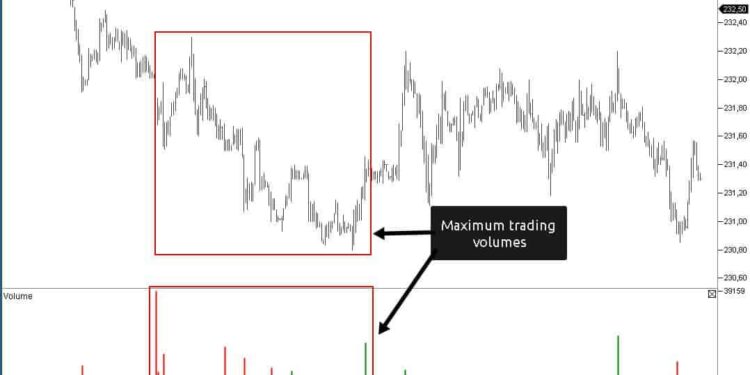Trade volume, or the volume of trade, signifies the quantity of shares exchanged within the stock market during a specific timeframe. The significance of the period over which trading volume is assessed cannot be overstated.
Trade volume is the total number of shares or contracts traded for a specific security, reflecting the frequency of investor involvement in simultaneous buying and selling of stocks.
Effortlessly gauging the volume of a particular security becomes feasible when there is a substantial presence of both buyers and sellers.
On the other hand, liquidity pertains to the ease with which a security can be bought or sold in the market. Higher liquidity facilitates retail investors‘ confidence in engaging with the market.
The liquidity of a stock denotes how quickly it can be bought or sold without significantly impacting the market. Consequently, higher liquidity contributes to smoother dealings with the particular security.
Liquidity risk emerges when investors encounter difficulty in finding a market for their stocks or securities, potentially leaving their stakes unsold or sold at an undesirable, notably low, price.
High volume implies a greater number of executed orders or increased trading transactions. In contrast, high liquidity denotes the ease with which a stock can be traded. The closer the liquidity, the lower the market impact cost and the greater the market efficiency.
Occasionally, higher liquidity transforms into high volumes when active buyers or sellers employing market orders display aggressiveness. Moreover, low trading volume does not necessarily equate to inferior liquidity. These two are one of the most prominent concepts to understand when it comes to stock markets and although they are interrelated, they also differ from each other.
Let’s dig deeper into understanding these two terms.
Understanding Volume vs. Liquidity
It’s essential to grasp the distinctions between liquid and illiquid markets. Market liquidity directly influences the bid-offer spread until securities are bought or sold.
As previously discussed, liquidity ensures the ease with which securities can be transacted in financial markets, involving both buying and selling, while maintaining stable prices.
Market liquidity, vital for several reasons, significantly impacts how quickly positions can be opened and closed. A liquid market, associated with lower risk, attracts speculators and investors due to the availability of counterparties for transactions.
In a liquid market, buyers easily find sellers and vice versa, contributing to efficient price discovery. Liquidity plays a pivotal role in determining the spread of a particular asset, tightening the bid-offer spread as the number of buy and sell orders increases.
In contrast, illiquid markets exhibit wider bid-offer spreads, impeding matching offer prices between sellers and buyers. This brings us to volume.
Volume is a fundamental aspect of any stock, indicating interest in the trading of that particular security. Higher volume suggests increased interest, while lower volume implies diminished interest in the stock.
Contrary to conventional wisdom, significant market movements don’t always require heavy volume, especially in the era of algorithmic trading. The adage “Never short a dull market” underscores the importance of considering volume analysis in the context of market conditions and other technical indicators.
In the space of financial markets, liquidity takes precedence when opening or closing positions. In a volatile market with limited buyers and sellers, closing positions becomes challenging, necessitating engagement with multiple parties to fulfill orders.
Markets with adequate liquidity are stable and foster a conducive investment environment. Therefore, assessing assets based on their current liquidity is crucial.
Stock volume reflects the stock’s activity and performance in the financial market, indicating high interest and activity surrounding the stock.
Liquidity assures investors of the ease with which they can retrieve their funds upon selling a security. Higher volume implies increased market participants, making trading sessions dynamic, especially during opening and closing periods.
This interplay between volume and liquidity proves beneficial for short-term intraday traders, utilizing these dynamics in their favor.
How Are Market Liquidity and Volume Related?
High liquidity in markets corresponds to low volatility, creating a stable environment. On the other hand, low liquidity increases the likelihood of price instability.
Markets with high liquidity, such as those dealing with bonds or blue-chip stocks, are characterized by stable prices, fostering a favorable environment for institutional investors.
Volume and liquidity are interlinked in the functioning of the market. Stocks with higher volume are traded more easily and swiftly than those with lower volume, indicating higher liquidity.
Consequently, stocks with lower volumes exhibit slower trading activity and possess lower liquidity. This lack of liquidity stems from diminished investor interest in dealing with such securities, resulting in low volume.
Liquidity and Volume, which is more important?
In financial markets, the relationship between volume and liquidity is a nuanced one. While they are often correlated, it’s crucial to recognize that volume and liquidity are independent variables, each with its unique implications for market dynamics.
Volume serves as a proxy indicator for liquidity, and the conventional belief is that high volume tends to indicate high liquidity. However, this correlation is not absolute, and the presence of one does not necessarily cause or dictate the other.
Consider a situation where a market experiences high volume – a flood of several traders actively participating. This heightened activity can indeed lead to increased liquidity as a greater number of market participants engage in buying and selling. On the other side of the coin, a highly liquid asset may attract substantial trading interest, resulting in high volume.
Conversely, markets struggling with low liquidity may witness low volumes, reflecting reduced interest in trading illiquid assets. The reciprocal relationship is evident, where low volume, signalling a lack of interest, prompts individuals to withdraw liquidity from the market.
However, the assumption that high volume equates to high liquidity is not universally true. In instances of an illiquid market, periods of high volume can emerge, causing significant price fluctuations. Similarly, a market characterized by high liquidity may experience low volume during periods of minimal market activity.
Both volume and liquidity are pivotal considerations for investors, but liquidity typically takes precedence. The level of liquidity directly influences the ease with which an investor can enter or exit a trade. In situations of low liquidity, trading tends to be sluggish, accompanied by wider spreads and slippage.
For short-term traders, however, volume becomes a vital factor. They seek markets with active participation and substantial interest in the near term. In such cases, a high volume indicates a vibrant market where short-term trading strategies can be executed effectively.
It’s essential for market participants to navigate the intricate interplay between volume and liquidity, recognizing their distinct roles and understanding that their correlation is not a steadfast rule in the dynamic landscape of financial markets.
In summary, liquidity is crucial for facilitating smooth transactions at preferred prices for traders. Meanwhile, volume serves as an indicator of interest in a specific asset, representing the total quantity bought or sold during a defined period.










